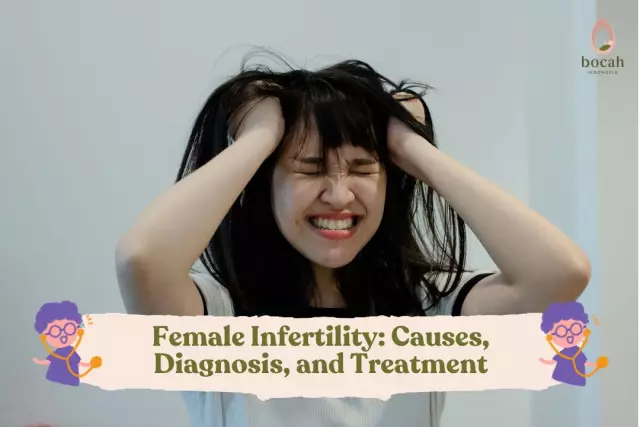- Author Rachel Wainwright [email protected].
- Public 2023-12-15 07:39.
- Last modified 2025-11-02 20:14.
Female infertility

In cases where a woman does not become pregnant after a year of regular sexual intercourse without the use of contraceptives, it is customary to talk about female infertility. In more than half of the cases, conception does not occur through the woman's fault. Female infertility is divided into primary, when pregnancy has never occurred, and secondary, if it has taken place.
Also distinguish between absolute female infertility and relative. In the first case, conception is impossible due to anatomical and physiological characteristics, such as underdevelopment or absence of the uterus and other female genital organs. In the second, pregnancy is possible after eliminating the causes of infertility.
Female infertility in itself is not a disease, but in most cases requires medical intervention, because only a specialist can establish the cause of this condition and choose the right tactics to eliminate this problem.
Causes of female infertility
The variety of causes of female infertility is amazing, but among them three main groups can be distinguished:
- obstruction of the fallopian tubes or tubal infertility. In this case, the causes of female infertility can be the consequences of diseases of the female genital organs of an inflammatory nature, caused in most cases by urogenital infections. This can also include adhesions after surgery, etc.
- violation of the menstrual cycle, in which there is no regular ovulation, or hormonal infertility. Most often this is caused by dysfunction in the work of the endocrine glands, which include the ovaries.
- violation of the process of introduction and attachment of a fertilized egg, for example, with endometriosis, after abortion and for a number of other reasons. This type of female infertility is called uterine.
In addition, abnormal structure and malformations of the pelvic organs, immunological factors, tumors and cysts of the ovaries and uterus of various etiologies, stress conditions, and genetic disorders are considered as the causes of female infertility. Sometimes conception does not occur even in cases where there are no reasons that prevent a favorable outcome.
Diagnosis of female infertility
A full examination, including diagnostic tests, is very costly, both financially and morally. By the time the diagnosis of female infertility takes about four to five menstrual cycles. This duration is due to the incompatibility of some procedures with each other and the fact that tests can be performed only on certain days of the menstrual cycle.
For any type of female infertility, diagnosis begins with taking anamnesis, gynecological examination and testing. An examination for urogenital infections is mandatory, an ultrasound of the pelvic organs is done, and a smear is taken to study the microflora of the vagina. A study of blood taken from an empty stomach from a vein from 5 to 7 days of the menstrual cycle helps to identify hormonal imbalances that prevent the maturation of the egg. As an aid for the diagnosis of female infertility, the basal temperature graph is used, with its help, the time of the onset of ovulation, if any, is found out.
A more reliable method for determining the timing of ovulation is a biopsy of intrauterine tissues, when a piece is taken from the surface of the uterus with a special instrument. Based on the data of microscopic examination of the sample taken, it becomes clear whether the uterine tissue was subjected to hormonal effects or not.
If an obstruction of the fallopian tubes is suspected, an x-ray examination, hysterosalpingography (HSG) or laparotomy are performed. The most reliable information about the state of the ovaries, tubes, uterus and the surrounding space can be obtained using the latter research method.
Treatment of female infertility
After the examination and depending on the results obtained, it is possible to prescribe either a more in-depth diagnosis, or, if the cause is identified, the most optimal method of treating female infertility:
- sexual intercourse during a period favorable for conception. Ovulation is calculated using a basal temperature chart or a pelvic ultrasound.
- hormonal therapy, during which the hormonal background is corrected, which means that the activity of the ovaries is normalized and the production of eggs is activated.

- if hormonal disturbances are minor, insemination is performed. This procedure consists in the introduction of the sperm of the sexual partner into the uterus during the most favorable period for pregnancy. As a rule, before this, stimulation of the ovaries with the help of hormonal agents is prescribed.
- in the absence of the effect of the treatment of female infertility, the best result is shown by in vitro fertilization (IVF), when the egg is fertilized with sperm outside the body of the expectant mother, and then placed in the uterine cavity.
- use of donor eggs. This can be either surrogacy, when a donor is carrying a child, or the introduction of donor eggs into the uterus of a sterile woman prepared with the help of hormones. This method is used in the case of severe genetic diseases or in the absence of the production of their own eggs.
Prevention of female infertility
As mentioned above, female infertility is not a disease, but adherence to a number of rules in many cases will help to avoid situations in which conception becomes impossible. The prevention of female infertility includes maintaining a healthy lifestyle, an orderly sex life, the use of contraceptives, timely treatment of urogenital infections and inflammation of the pelvic organs. It is very important to regularly visit a gynecologist, because the disease is much easier to prevent or treat when it has not yet become severe.
YouTube video related to the article:
The information is generalized and provided for informational purposes only. At the first sign of illness, see your doctor. Self-medication is hazardous to health!






